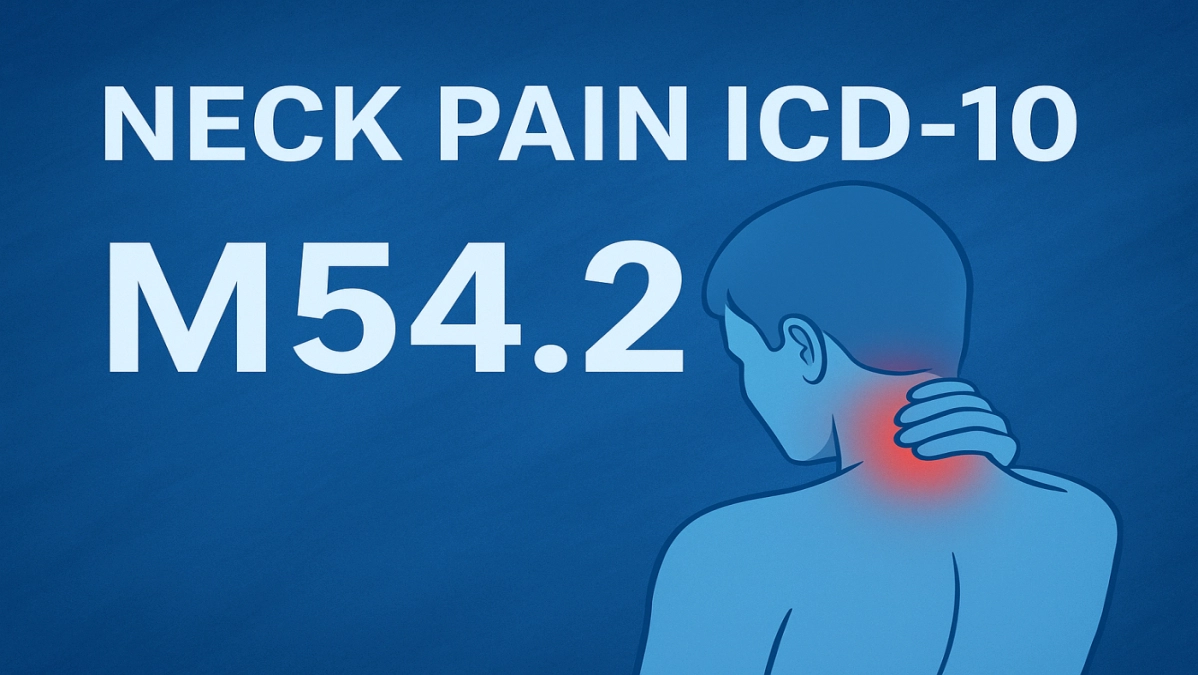Neck pain is one of those issues that almost everyone experiences at some point—whether from poor posture, a car accident, or long-term wear and tear on the spine. In healthcare, however, describing “neck pain” isn’t enough. Providers and billers must assign a precise diagnosis code so insurance companies can process claims correctly.
In ICD-10, the system used worldwide for diagnostic coding, the standard code for neck pain is M54.2 – Cervicalgia. But here’s the catch: not all neck pain is coded the same way. The right code depends on cause, severity, and whether the pain is acute, chronic, or linked to another condition.
The Primary ICD-10 Code for Neck Pain
- M54.2 – Cervicalgia
- This is the official ICD-10 code for neck pain.
- Defined as “pain in the cervical spine region.”
- Use this code when documentation simply states “neck pain” without further specifics.
This is the most commonly used diagnosis code, but relying on it too often can lead to claim denials if a patient’s records show more detail.
Related ICD-10 Codes for Neck Pain
Neck pain doesn’t exist in isolation. Depending on what the provider documents, the correct code may shift:
- M54.12 – Radiculopathy, cervical region (nerve pain radiating from the neck into the arm)
- M50.20–M50.23 – Herniated cervical disc (pain caused by a bulging or slipped disc)
- M50.30 – Cervical degenerative disc disease, unspecified
- M54.10–M54.19 – Cervical radiculopathies (other specific cases)
- S13.4 – Whiplash injury (if pain stems from trauma like a car accident)
Chronic vs. Acute Neck Pain Coding
For chronic neck pain, M54.2 still applies, but coders often add a secondary code:
- G89.29 – Other chronic pain, not elsewhere classified
- Or G89.21 – Chronic pain due to trauma, if the condition is linked to injury
This distinction matters because payers may treat chronic pain differently from acute cases in terms of reimbursement and treatment authorization.
Documentation Requirements for Accurate Coding
Medical billers can only code what is documented. That means providers should note:
- Cause – Is it strain, disc herniation, arthritis, whiplash, or nonspecific pain?
- Chronicity – Acute (short-term) vs. chronic (lasting more than three months).
- Associated symptoms – Radiculopathy, limited motion, headaches, or neurological deficits.
- Laterality – Left-sided, right-sided, or unspecified.
- Impact – How the pain affects daily function (important for justification of therapy).
Without these details, claims coded only with M54.2 may get flagged for insufficient documentation.
Patient Perspective: Why ICD-10 Codes Matter
If you’re a patient, ICD-10 codes might look like meaningless numbers. But they play a big role in your care. For example:
- Insurance approvals – Physical therapy or MRI requests often require the right ICD-10 code.
- Chronic pain recognition – Using the right code ensures your condition is seen as long-term, which may affect medication coverage.
- Specialist referrals – Neurology, orthopedics, and pain management clinics all rely on these codes for coordinated care.
ICD-9 vs ICD-10: What Changed?
- ICD-9 code for neck pain: 723.1
- ICD-10 code for neck pain: M54.2
The shift to ICD-10 wasn’t just about renumbering. It added more specificity, letting providers and billers distinguish between conditions like herniated discs, radiculopathy, and simple cervicalgia.
Common Coding Errors to Avoid
- Overusing M54.2 – Defaulting to cervicalgia even when a more specific condition is documented.
- Forgetting secondary codes – Chronic pain cases often need an additional G89 code.
- Ignoring trauma codes – Whiplash and accident-related neck injuries require injury codes, not just M54.2.
- Not updating annually – ICD-10 codes are revised every year. Using outdated codes risks denials.
Quick Reference Table: ICD-10 Codes for Neck Pain
| Condition | ICD-10 Code | Notes |
|---|---|---|
| General neck pain (cervicalgia) | M54.2 | Default code for unspecified neck pain |
| Chronic neck pain | M54.2 + G89.29 | Add chronic pain code for specificity |
| Cervical radiculopathy | M54.12 | Pain radiating to arms |
| Herniated cervical disc | M50.20–M50.23 | Depends on location & specifics |
| Whiplash injury | S13.4 series | For trauma-related pain |
| Degenerative disc disease | M50.30 | Unspecified cervical degeneration |
Key Takeaways
- M54.2 (Cervicalgia) is the primary ICD-10 code for neck pain.
- Always consider chronicity, cause, and associated symptoms before assigning a code.
- Pair M54.2 with G89 codes for chronic cases.
- Accurate documentation is the key to avoiding claim denials.
Suggested Internal Links for a Blog
- “Herniated Disc ICD-10 Codes Explained” – to complement the cervical disc section.
- “Chronic Back Pain ICD-10 Guide” – for readers with broader spinal pain coding needs.
- “Why Insurance Denies Pain Management Claims” – ties directly into the billing accuracy angle.
FAQs
Q1: What is the ICD-10 code for neck pain?
A: M54.2 – Cervicalgia is the standard code.
Q2: Does ICD-10 have a separate code for chronic neck pain?
A: Not directly. Use M54.2 with a chronic pain code like G89.29.
Q3: How is neck pain with nerve symptoms coded?
A: Use M54.12 – Cervical radiculopathy.
Q4: Can M54.2 be used for whiplash?
A: No. Whiplash has its own codes under the S13.4 series.
Q5: Why do claims with M54.2 sometimes get denied?
A: Usually because documentation lacks detail, or a more specific code should have been used.

